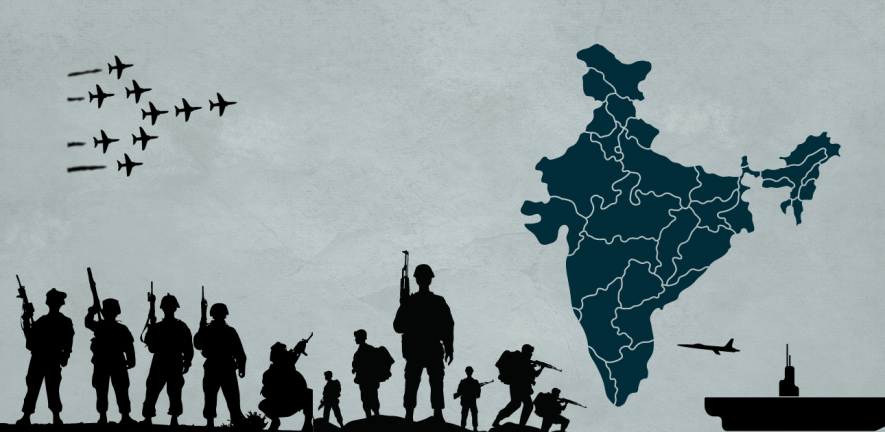Effective Centre-State Dynamics a Must for Any Mechanism to Counter Terrorism

Representational Image.
The Union Home and Coooperation Minister, Amit Shah’s proposal for a common strategy to be pursued by all the states to fight crime and terrorism under the “spirit of cooperative federalism” sounds attractive, but how it is implemented would be the key to its success.
—-
On Thursday, the Union Home Minister, Amit Shah, while addressing the two-day Chintan Shivir (brainstorming session) on various internal security issues, for the State Home Ministers, Home Secretaries and Directors-General of Police and Central Armed Police Force (CAPF), at Surajkund, Haryana, emphasised the need to formulate a common strategy to fight crime, which he claimed, is now becoming borderless. In particular, he referred to the three Cs, namely, Cooperation, Coordination and Collaboration between the Centre and the States, to make this a success.
The proposal for a common strategy is one more instance in recent years, to justify growing centralisation in and uniform policy, across all the states, on law and order. That the Home Minister also mentioned in the same speech referred to earlier, issues such as centralisation of data on terror and other crimes, the need to have a National Investigation Agency office by 2024 in every State with powers to confiscate property in terror cases, and the principle of “one data, one entry” makes it clear that the Centre is likely to pursue this project, without sufficiently allaying the states’ concerns about the erosion of their powers.
Unitary bias
According to Article 1(1) of the Indian Constitution, India is a Union of States. This naturally implies that the multiplicity of states would require effective cooperation not just between states, but also between the Centre and the states. To address the same, India follows the federalist structure.
Though the word ‘federalism’ is not mentioned in the Indian constitution, courts have recognised it as part of its basic structure. Scholars have, however, found India’s federal structure as heavily centralised. Articles 3 and 4 of the Constitution give the central government broad powers to create and alter states. Article 360 (provision for financial emergency) gives the power to even turn around the entire federal arrangement.
The Constitution of India, under Article 355, obligates the Centre to protect the States against internal disturbance as well as external aggression. By doing so, the Constitution not only obligates the Centre to impinge the jurisdictions of the States, but also gives it complete autonomy and discretion throughout the process. Moreover, this is also firmly supported and upheld by the Supreme Court.
An example of federalism with a unitary bias is seen in Kuldip Nayar versus Union of India where the court held that federalism meant only the division of power between Centre and states, and territorial nexus was not a part of it. It further held that India follows the holding-together federalist structure and hence has an inherent unitary bias. Moreover, the Rajya Sabha was only said to represent party interests and not that of states. . Thus, federalism in India is construed to be Centre-leaning.
The 2008 Mumbai terror attack
The 2008 Mumbai terror attacks wreaked havoc in the city with terrorists entering through the sea route via Colaba and carrying out attacks at various locations. The High Level Enquiry Committee (HLEC) that was set up to probe the events that unfolded, released a report that was submitted to the government of Maharashtra but was not made public. The Commonwealth Human Rights Initiative (CHRI) filed a Right to Information application with the Maharashtra Home department and managed to translate the Marathi report to English.
According to the report, there were multiple intelligence alerts received by the state intelligence agencies from the central ones but were not taken seriously and were mechanically forwarded to the Anti-Terrorism Squad (“ATS”) and the Director General of Police’s (“DGP”) Office. The report also observed how Mumbai Police’s Quick Response Team (“QRT”) was not equipped to handle terrorist attacks with their activity confined to the police station. Moreover, though the maritime security jurisdiction was designated to the Indian Navy, the role of the Mumbai Police was unclear, leading to confusion.
This is precisely why effective federalism becomes important. Inherent distrust and friction between central and state agencies, confusion regarding jurisdictions (in this case, maritime security) etc., can only be resolved by strengthening the boundaries and having clear specifications on jurisdictions.
The distrust can be done away with only when state entities do not feel that the central agencies are encroaching on their territory. To avoid this, Centre-state cooperation is a sine qua non. Thus, if there had been efficient collaboration, there was a chance to reduce the casualties or possibly even thwart the entire attack, had the reports been taken seriously.
The Constitution of India, under Article 355, obligates the Centre to protect the States against internal disturbance as well as external aggression. By doing so, the Constitution not only obligates the Centre to impinge the jurisdictions of the States, but also gives it complete autonomy and discretion throughout the process. Moreover, this is also firmly supported and upheld by the Supreme Court.
In Sarbananda Sonowal v. Union of India, the court struck down the Illegal Migrants (Determination by Tribunals) (“IMDT”) Act. One reason given by the court was that the IMDT Act placed the burden on the state to prove that a person was an illegal migrant as opposed to the Foreigner’s Act, which applied pan-India. This violated Article 355 since it was the Centre’s role to ensure protection in cases like these and this role reversal was not permissible. Thus, the Supreme Court upheld the overarching role of the Centre, although the judgment subsequently came in for criticism that it perpetuates a culture of mass suspicion, with no legal framework in place to ensure accountability.
The decision of this case can also be extrapolated to be applied to counter-terrorism measures in order to look at the role/obligations of central investigation agencies. The creation of agencies like National Investigation Agency (NIA) and National Counter Terrorism Centre (NCTC) by the Centre in the aftermath of the Mumbai terror attacks of 2008 for better counter-terrorism mechanisms, led to ceding of immense powers in the hands of these entities.
The National Investigation Agency (Amendment) Act, 2019 gave NIA the same powers as the State’s police. Moreover, unlike the CBI, which is also a central investigation agency, the NIA doesn’t need the respective state’s consent to carry out investigations and the State cannot object to the same. The amendment also allows the Union to set up special courts to deal with NIA cases.
India’s experiment with cooperative federalism in the context of investigation by the CBI and the NIA has not been entirely satisfactory, as a serious trust deficit between the Centre and the States has limited its potential for success.
This overarching power given to the Centre via article 355 was naturally met by resistance from States. In Pragyasingh Chandrapalsingh Thakur versus State of Maharashtra, (2013) the validity of enacting the NIA Act and the legislative competence of the Centre for the same was challenged before the Bombay High Court. It was contended that in lieu of Article 355, the Centre was taking over the functions of the States and was impinging on the powers of the State to have jurisdiction on the matters of Police given under List II. It was hence urged by the petitioners to declare the Act ultra-vires the constitution.
The Bombay High Court, however, upheld the constitutionality of the Act reasoning that the Parliament was within its legislative power to enact the same. It urged for a harmonious construction between Entry 8 of List I and Entries 1 and 2 of List III that talk about setting up a central bureau of investigation and taking decisions pertaining to criminal laws and procedures respectively. The court held that ‘Police’ included under List II would only mean that was left after other powers under Lists I and III were enumerated and thus, matters including the security of the state (defence of the country) relating to Military, Navy and Air Force etc. would exclusively come under the powers of the Union.
The court also held that the NIA would not usurp the powers of the States and was only meant to supplement them. Moreover, creating the NIA would not mean that the Centre would transfer all cases to it, but would undertake fair procedure and assess the gravity of the situation meticulously before transferring any case.
The court’s reasoning that terrorism shakes the very basis of the country and hence the Parliament has to step in, in order to take effective measures raises a few questions of significance.
If terrorism is such a deep-rooted problem, why not strengthen State agencies to tackle the issue? This would in turn ensure better efficiency as every State will be equipped with its own counter-terrorism apparatus and won’t have to rely on the Centre, which could cause communication gaps and delays.
Moreover, when the high court holds that the Centre will be scrupulous in deciding the matter of transfer of cases, it is assuming a very Utopian institution. There have been instances where States have complained of misuse of powers by the Centre through the NIA for political purposes and to clamp down on dissent as well.
The concern about the Centre overstepping its jurisdiction also played out when the Union government sought to set up the NCTC as a nodal institution for coordinating with the state and central investigation agencies. Just like with the NIA, the states objected to its setting up, arguing that it would lead to defeating the federal spirit. The NCTC, like the NIA, was given powers (including arrest) akin to those of the state police and also did not require prior consent or approval from the states.
As pointed out by scholar, Vinay Kaura (“India’s Counter-Terrorism Policy against Jihadist Terror”, available here (2017) ), it is a commonly accepted principle in all liberal democratic countries that an intelligence agency should not possess police powers of arrest. If NCTC is made part of Intelligence Bureau (IB), the powers given to it under the Unlawful Activities (Prevention) Act (UAPA) could be misused, as IB is practically immune from any parliamentary oversight and its lack of parliamentary accountability would be further perpetuated by NCTC, according to Josy Joseph, journalist.
The abdication of the responsibility by the state government to investigate a crime, because it involves sharing of inputs from other agencies may have an adverse influence on the very efficiency of its police force.
It is not surprising, therefore, that despite its creation in 2012, the NCTC has not yet been operationalised because of the concerns of the state governments over its powers. In 2020, the Union Minister of State for Home, G.Kishan Reddy, in a written reply to a question in the Lok Sabha, appeared to rule out any initiative to operationalise it on the ground that there is already effective coordination among the agencies in gathering and sharing of intelligence, and investigation, and taking action to prevent terrorism.
Though the apprehension of central agencies encroaching on the states’ jurisdiction is a reasonable one, it is to be looked at in the context of counter-terrorism. With operations riddled with sensitive information, that is strenuous to both procure and keep confidential, it is to be seen if states are equipped with the wherewithal to do so. Even if it is argued that state institutions be empowered, a question of feasibility arises. With 28 States and eight Union Territories, it will be an arduous task to equip each of them with effective counter-terrorism measures without having to rely on the NIA. Though this is possible, it is a measure to be implemented over a course of time and should definitely be undertaken in the near future.
As for the present, India must practice what Granville Austin called ‘Cooperative Federalism’. Though India has a federal structure, what is lacking is the concept of trust and cooperation between the Centre and States.
Thus, the central agencies can get access to sensitive information that states might not, due to the very nature of the Centre having greater powers (having been equipped to deal with terrorism on a pan-India level). At the same time, states might have access to local, ground-level sensitive issues. Efficient teamwork and information sharing between the Centre and the States i.e., cooperative federalism could be an antidote to terrorism.
Turf battle
The CBI, which is established under the Delhi Special Police Establishment Act, 1946 (“DSPE”) needs the consent of the state governments to carry out investigations under section 6. This consent was given in the form of a general consent by various states to avoid repeated requests. However, apprehensions of misuse of powers bestowed to the CBI for political aspirations have led to nine states revoking general consent.
The most conspicuous controversy was the one that erupted between the State of West Bengal and the CBI after the assembly poll violence in the state in 2021 when the CBI took over the investigation and the general consent was revoked. Other states, ruled by non-BJP opposition parties, like Maharashtra also followed suit. However, following the return of the BJP to power in the new coalition government in Maharashtra, the state government has now restored the consent given to the CBI earlier.
India’s experiment with cooperative federalism in the context of investigation by the CBI and the NIA has not been entirely satisfactory, as a serious trust deficit between the Centre and the States has limited its potential for success. The ongoing two-day ‘Chintan Shivir’ at Surajkund, Haryana may help in creating a favourable climate for greater centralisation in fighting crimes like terrorism and cybercrime which cut across state boundaries, and have all-India ramifications. However, any strategy in this direction can succeed only if the Centre allays the apprehensions of States on erosion of their powers, and secures their trust.
As pointed out by Kaura in his scholarly paper (2017) referred to in this article earlier, India’s response to terrorism has been largely characterised by ad-hocism, which has often led towards the creation of new agencies, meta-institutional innovations, and over-centralisation, an illusion of power created by technological acquisitions, and the states abdicating their law and order responsibilities.
This was very much evident in the recent car blast case in Coimbatore, wherein the Tamil Nadu Government abandoned the initial investigation by the Tamil Nadu police, and requested the NIA to take over the probe. The prompt abdication of the responsibility by the state government to investigate a crime, because it involves sharing of inputs with other agencies may have an adverse influence on the very efficiency of its police force.
Therefore, there are many questions surrounding the Centre’s pursuit of the three Cs – Cooperation, Coordination and Collaboration between the Centre and the states – to evolve an effective strategy to counter cybercrime and terrorism, and its success would hinge on whether the answers to those concerns are valid, considering India’s experiments with similar efforts in the past.
(with editorial inputs)
Aastha Malipatil is a second-year law undergraduate student at the National Law School of India University, Bangalore.
Get the latest reports & analysis with people's perspective on Protests, movements & deep analytical videos, discussions of the current affairs in your Telegram app. Subscribe to NewsClick's Telegram channel & get Real-Time updates on stories, as they get published on our website.
























